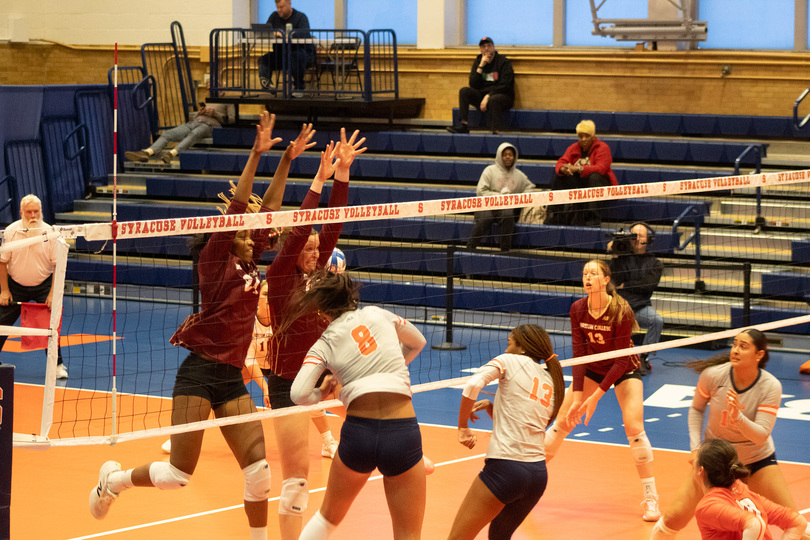BC’s blocking stifles Syracuse attack, Orange drop to .500 in ACC play

Boston College’s blocking dominance propelled the Eagles to sweeping Syracuse Friday. BC held SU to just a .137 hitting percentage. Isabella Flores | Staff Photographer
Get the latest Syracuse news delivered right to your inbox. Subscribe to our sports newsletter here.
Syracuse entered Friday’s matchup against Boston College with momentum.
On Wednesday night, the Orange pulled off a gritty 3-2 win in Chestnut Hill over BC. Syracuse’s Gabriella McLaughlin dominated with 22 kills and 14 digs, her 12th double-double of the season. Freshman outside hitter Marie Laurio earned her first career double-double, recording 10 kills and 13 digs.
SU had the psychological edge and the series lead coming into Friday’s match at home, while Boston College chased redemption. The Eagles got it thanks to their dominance at the net.
From the opening serve, BC (15-7, 4-6 Atlantic Coast) made its defensive presence felt, controlling the net to take down Syracuse (13-7, 5-5 ACC) in straight sets. Every time the Orange appeared to find their rhythm, the Eagles’ front-row defense shut them down with blocks. By the end of the match, the Eagles’ blocking dominance had not only limited Syracuse’s hitting percentage to .137, but also set the tone for a one-sided battle in front of the SU home crowd.
Boston College’s blocking game came from all angles. Bella Ehrlich led the effort with a match-high nine blocks, while Anna Herrington added six. The Eagles totaled 12 team blocks to Syracuse’s four. Their coordination at the net forced the Orange hitters to adjust mid-air, often tipping or tooling the block rather than swinging confidently.
Syracuse’s top hitters, particularly Skylar George and Zharia Harris-Waddy, faced constant resistance, managing just 38 combined kills for the team on 124 attempts.
“BC has a big block, they have been a really good blocking team for years and we know that,” SU head coach Bakeer Ganesharatnam said. “We have undersized hitters and it makes a big difference if you’re 6’6, and unfortunately we’re not, and that’s alright.”
Cornelia Roach wreaked havoc at the net all night. Every touch at the net seemed to redirect Syracuse’s rhythm, and her awareness turned potential Orange kills into transition opportunities for BC. Her eight block assists accounted for nearly half of the team’s total.
Over the past few weeks, Syracuse’s matches have followed a familiar pattern — opponents are stacking up double-digit block totals.
Boston College, Virginia, Virginia Tech and Colgate all notched 12 or more team blocks against the Orange, exposing a recurring theme — Syracuse’s offense is being challenged, if not outright contained, by some of the ACC’s and region’s most physical front rows.
Even in Syracuse’s five-set win over Boston College on Wednesday, the Eagles tallied 14 blocks. The difference between the two matches shows how crucial blocking battles have become to the Orange’s success.
Syracuse’s ability to match or overcome opponents at the net often dictates its performance. When the Orange keep pace in the blocking column, as they did in Wednesday’s win, their defensive energy translates into momentum and scoring runs. But when the block disappears, as it did in the rematch, the entire rhythm collapses.
“Boston made great adjustments and their block is huge,” setter Tehya Maeva said. “We know we have to be crafty and smart. We’re not the tallest team, but that’s how we make our points, and we could have executed better today.”
Virginia and Virginia Tech each recorded 12 blocks against Syracuse earlier this month, forcing Orange hitters into coverage situations rather than kill opportunities. Against Colgate, the Raiders’ 12-block effort also contributed to one of Syracuse’s most uneven offensive outings.
For Ganesharatnam, the trend is both a concern and an opportunity. Syracuse’s offense is quick and athletic, but it often struggles against teams that use size and timing to control the net. Finding ways to attack around or through those walls will be crucial if the Orange want to finish strong in ACC play.






